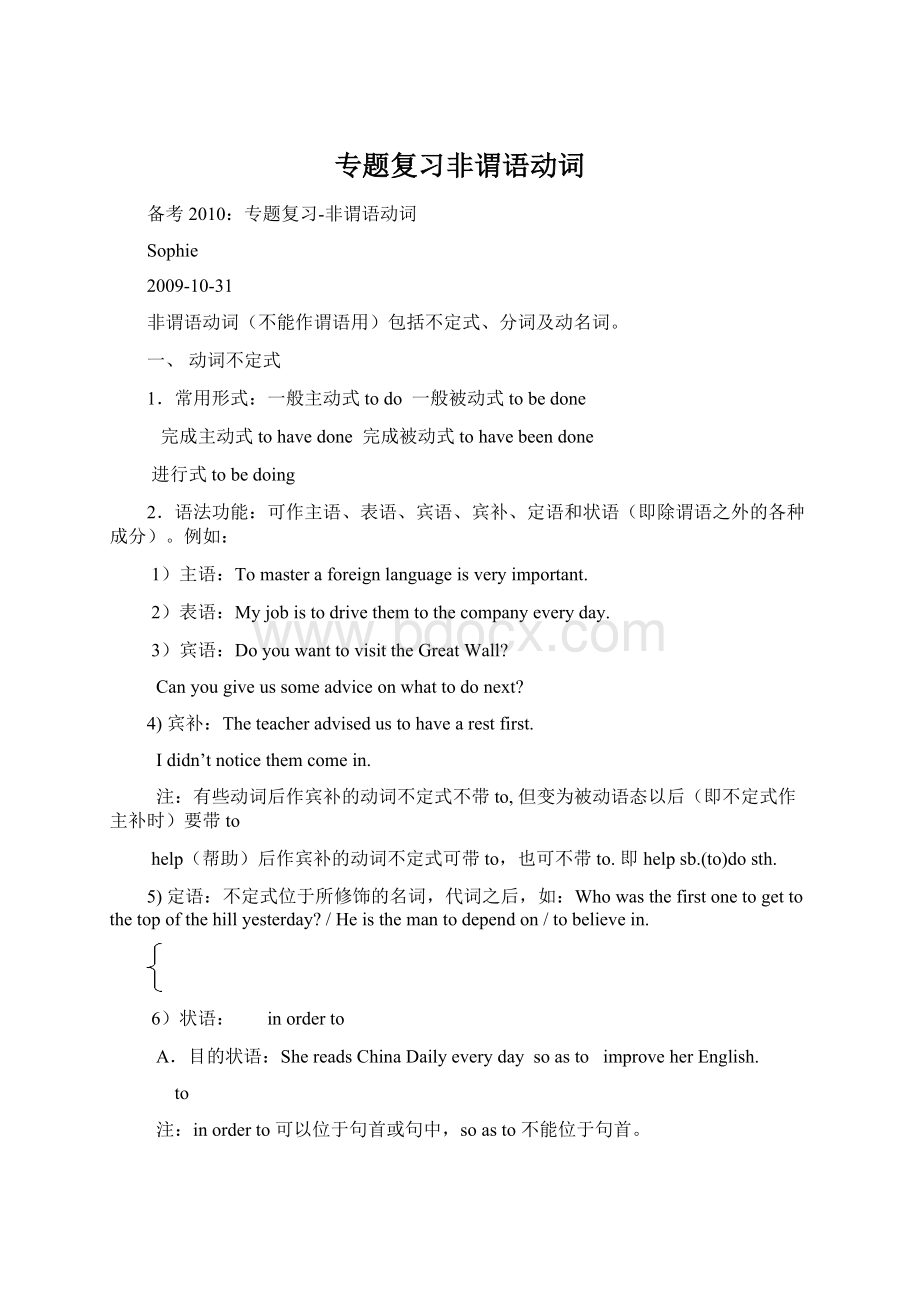 专题复习非谓语动词Word文档格式.docx
专题复习非谓语动词Word文档格式.docx
- 文档编号:18758425
- 上传时间:2023-01-01
- 格式:DOCX
- 页数:18
- 大小:33.73KB
专题复习非谓语动词Word文档格式.docx
《专题复习非谓语动词Word文档格式.docx》由会员分享,可在线阅读,更多相关《专题复习非谓语动词Word文档格式.docx(18页珍藏版)》请在冰豆网上搜索。

help(帮助)后作宾补的动词不定式可带to,也可不带to.即helpsb.(to)dosth.
5)定语:
不定式位于所修饰的名词,代词之后,如:
Whowasthefirstonetogettothetopofthehillyesterday?
/Heisthemantodependon/tobelievein.
6)状语:
inorderto
A.目的状语:
ShereadsChinaDailyeverydaysoastoimproveherEnglish.
to
inorderto可以位于句首或句中,soasto不能位于句首。
B.原因状语:
Imgladtoseeyou.注:
这种“be+形容词+不定式”结构,其不定式有时也可视为宾语,如:
Heiseagertogotocollege./Sheissuretocomehere.
C.结果状语:
Theylivedtoseetheliberationoftheirhometown.他们一直活到见到家乡解放。
△在“too…to…”结构中表“太…结果不能”,如:
Heistooweaktodothework.
注:
too之前如果有only,onlytoo表“非常”、“很”意,此时不定式不再表否定意,而表肯定意。
如:
Theyareonlytooluckytogoabroadforavisit.他们很幸运去国外访问。
另外,too后如果是happy,glad之类形容词时,不定式也表肯定意,
如:
Shewastoohappytomeetheroldfriendinthestreet.
△在“形容词/副词+enough+不定式”结构中表“足以能…”,如:
Heisstrongenoughtodothework.
3.复合结构不定式(forsb.todosth.),可作主语、表语、宾语、定语和状语。
for本身无意义,sb.可称之为不定式的逻辑主语。
Ithinkitnecessaryforhimtogothereatonce.(复合结构作宾语)
当作表语用的形容词表示不定式的逻辑主语的性质或特征时,不用for,而用of,
Itiskindofyoutohelpme.(相当于Youarekindtohelpme.)这类形容词有good,nice,kind,wise,clever,foolish,silly,stupid,careless,impolite(不礼貌)等。
right,wrong既可用于forsb.todosth.也可用于ofsb.todosth.如:
It’sright/wrongfor/ofhimtodotheworkalone.
4.疑问词+不定式:
可作主语、表语或宾语。
Howtofinishtheworkintimeisaproblem.(主语)
Wedon’tknowwhenandwheretogo.(宾语)
5.动词不定式的否定式(nottodosth.),语法功能同不定式肯定式。
6.不定式的时态形式所表示的时间关系:
1)一般式:
表示的动作和谓语动词所表示的动作同时发生,或在谓语动作之后,或没有时间限制。
如:
Theyoftenwatchusplaytabletennis.(与谓语动作同时)
Shehopestogothereagain.(在谓语动作之后)
ItisnecessaryandimportanttoreadEnglisheveryday.(无时间限制)
Thefactorytomakeradiosisoverthere.(无时间限制)
2)完成式:
表示的动作在谓语动词所表示的动作之前。
I’msorrytohavekeptyouwaiting./Sheseemstohavebeenateacherformanyyears.
3)进行式:
表示正在发生的动作且与谓语动作同时发生。
ShehappenedtobewritingaletterintheroomwhenIcomein.
7.不定式的被动式:
名词、代词为不定式的逻辑宾语时,一般用不定式被动式,
例如:
Whatistobedoneisunknown./Thebridgetobebulitthereisverylong.
二、分词
1.分词形式:
有现在分词和过去分词两种。
过去分词只有一种形式,现在分词则有:
一般主动式doing,一般被动式beingdone,完成主动式havingdone,完成被动式havingbeendone
在句中作定语、表语、宾补、状语。
3.现在分词和过去分词的区别:
1)语态不同:
现在分词表示主动概念,及物动词的过去分词表被动概念。
arunningmachine一台转动的机器,astolencar一辆被盗的汽车
2)时间关系上不同:
现在分词表正在进行的动作,过去分词往往表已经完成的动作。
adevelopingcountry发展中的国家,adevelopedcountry发达的国家
4.现在分词的基本用法:
1)一般主动式用法:
A.作定语:
Thesleepingchildisonlyfiveyearsold.(=Thechildwhoissleepingis…)/ThegirlwritingalettertherecanspeakEnglishverywell.(=Thegirlwhoiswritingalettercan…)
ThefactorymakingTVsetsisverylarge.(=ThefactorywhichmakesTVsetsisverylarge.)
B.作表语:
Thestorysoundsveryinteresting./Thenewsisveryexciting.
C.作宾补:
学用于see,watch,hear,feel,find,have,keep等动词之后。
Wecanseesteamrisingfromthewetclothes./IsawTomcomingoutofthehouse./Dontkeepthestudentsdoinghomeworkallday.
上述动词后跟不定式作宾补表示动作的过程,而不是正在进行中的动作,而现在分词作宾补则表示正在进行中的动作。
IheardthemsingingintheroomwhenIpassedit.(singing不可改为sing)
Doyouoftenhearthemsingintheroom?
(sing不可改为singing)
havesb.dosth.与havesb.doingsth.的区别:
前者have=let,后者have有时表“keep”意,有时表“employ(雇用)”意。
I’llhavehimgowithme.我将让他和我一块去。
I’llhavehimworkinginmycompary.我将雇用他在我的公司里工作。
Don’thavethemachineworkingallday.不要让机器整天工作。
D.作状语:
①时间状语:
Readingtheletter,Icouldn’thelpthinkingofmyschoollife.
②原因状语:
Beingill,Ididn’tgotoschoolyesterday.
③方式或伴随状语:
MarystoodattheschoolgatewaitingforBetty.
2)完成主动式用法:
这种分词所表示的动作发生在句中谓语动词所表示的动作之前,一般在句中作时间或原因状语用,不能作定语用。
Havingfinishedherhomework,shewenttobed./Nothavingreceivedhisletter,shewrotetohimagain.
3)一般被动式用法:
表示正在发生的被动动作,在句中作定语或状语。
Thecarbeingrepairedismine.(=Thecarwhichisbeingrepairedismine.)/Beingrepaired,thecarcan’tbeused.(=As/Becauseitisbeingrepaired,thecarcan’tbeused.)
4)完成被动式用法:
表示发生在谓语动作之前的被动动作,在句中多作状语,不能作定语。
Havingbeenpraisedasecondtime,Idecidedtomakestillgreaterprogress.
5.过去分词的基本用法:
1)作定语:
Thestolencarwasfoundbythepolicelastweek.
2)作表语:
Theglassisbroken./WhenIgottotheclassroom,thedoorwaslocked.
3)作宾补:
Youmusthave/getyourhaircut.
4)作状语:
Givenmoretime,wecandotheworkmuchbetter.
6.独立主格结构:
当分词有它自己的独立主语(不同于句子主语的名词或代词)时,则是一种独立主格结构形式,在句中作状语、定语等。
Thebellringing,weallstoppedtalking.(=Whenthebellrang,weallstoppedtalking.)
Therebeingnobus,wehadtowalkhome.(=Therewasnobus,sowehadtowalkhome.)
7.注意作状语用的分词,其逻辑主语必须同句中主语为同一人或同一事,如:
Standingontopofthetallbuilding,wecouldseethewholecity.(T)(Standing=Whenwestood)
Standingontopofthetallbuilding,thewholecitycouldbeseen.(F)
Havingfoundthecause,theycontinuedtheexperiment.(T)(Havingfound=After/Whentheyhadfound)
Havingfoundthecause,theexperimentcontinued.(F)
8.现在分词被动式与过去分词用法的区别:
现在分词被动式与过去分词都有被动意,但其用法是有区别的:
beingbuilt
(1)作定语时,现在分词的一般被动式表示一个正在发生的被动动作,过去分词则表示一个已发生过的被动动作或没有时间性的状态。
built
Doyouseethehospitalthere?
正在建造的
建好的
你看见了那边那个医院了吗?
ThecontinentconnectedwithAsiaattheSuezCanalisAfrica.在苏伊士运河处与亚洲相连的洲是非洲。
(句中connected无时间性)
(2)作时间状语,若动作先于句子的谓语动作,且有具体过去时间,不可用现在分词一般被动式或完成被动式。
Builtin1192,thebridgewasveryuseful.
如果没有具体过去时间状语,可用过去分词或现在分词完成被动式。
Discussed(=Havingbeendiscussed)manytimes,theproblemwassettledatlast.
若强调分词状语的动作发生的时间在谓语动作之前,则宜用现在分词完成被动式,不用过去分词。
Nothavingbeeninvited,shehadtostayathome.
9.心理状态动词的-ing形式与-ed形式
所谓心理状态动词是指含有使动意,使人产生某种情感、心理变化的动词。
surprise使惊讶;
interest使感兴趣。
它们的-ing形式与-ed形式皆可视为形容词。
surprising令人惊讶的,interesting令人感兴趣的;
surprised(因…)感到惊讶的,interested(因…)感到兴趣的。
注意两者的区别:
Thefilmissointerestingthattheyareallinterestedinit.
Shewasmuchsurprisedatthesurprisingnews.
已学的心理状态动词有:
astonish,bore,delight,disappoint,discourage,encourage,excite,frighten,interest,move,please,puzzle,satisfy,surprise,shock,tire,trouble,upset(使不安),worry
它们的-ing形式多和物连用,如:
pleasingnews/aboringreport/atiringwalk
它们的-ed形式多和人连用,如:
anexcitedgirl/I’mtired.
但也有-ing形式和人连用,-ed形式和物连用的现象。
aninspiringleader一位有感召力的领袖,apuzzledexpression一种迷惑不解的表情,Shesaidinafrightenedvoice.她用惊恐的声音说着话。
三、动名词
1.形式同现在分词,有四种。
2.动名词的基本用法:
1)作主语:
Seeingisbelieving./Talkingiseasierthandoing./itisn’tnecessaryexplainingtohim./It’snousewaitinghere.
Myhobbyiscollectingstamps./Hisjobiswashingandcooking.
3)作宾语:
Whenhecamein,weallstoppedtalking./Hehasgivenupsmoking./WeoftendoourcleaningonSaturdayafternoon./Areyoufondofdancing?
/Theboyisntworthteaching.
注:
有些动词后只能跟不定式作宾语。
有些动词后只能跟动名词作宾语,有些动词既可后跟不定式又可后接动名词作宾语但差别不同大,还有些词则差别较大,应注意区分。
4)作定语:
Thisisherfatherswalkingstick.
3.动名词的复合结构:
形式:
his/himworkingthere,WangDongs/WangDongworkingthere
语法功能:
Yoursmokingtoomuchwilldoharmtoyourhealth.(动名词的复合结构在句首作主语时,只能用sb’s的形式,此句中的Your不可改为You。
)
2)作宾语:
Idon’tlikehis/himstayingwithus.
3)作表语:
Myjoyishiswinningthetable-tennisgame.(his不能改为him)
4.动名词的完成式:
动名词的一般式所表示的动作为一种时间要领不强的或泛指的动作,或是与句中谓语同时发生。
或在谓语之后发生的动作。
如果动名词的动作发生在谓语动作之前,则要用完成式。
Wewerepraisedforhavingcompletedourtaskaheadoftime.
lending
g
在remember,forget,regret,excuse,apologize等动词之后,某些介词后,或某些习惯用语中,用动名词的一般式就可以表示完成式的概念。
havinglent
Irememberhimsomemoneybefore.
promising
havingpromised
Heforgotmethat./Afterfinishinghishomework,hewentoutforawalk.
5.动名词的被动式
如果动名词的逻辑主语为动名词所表示动作的承受者,这个动名词就要用被动式。
Theproblemisfarfrombeingsettled.
动名词的完成被动式往往用一般被动式来代替,以免句子显得累赘。
Istillrememberbeinginvited(代替havingbeeninvited)byafamousartistwhenIwasinShanghai.
6.动名词与不定式作主语、宾语的用法比较
<
1>
作主语:
(1)多数情况两者可以互换。
Seeingisbelieving.=Toseeistobelieve.
Talkingiseasyanddoingisdifficult.=Totalkiseasyandtodoisdifficult.
(2)如果表示一种具体、短期的行为,或表示将来的行为,宜用不定式。
Ittookhimtwohourstofinishthework.
Tobeascientistishisdesire(愿望).
(3)如果表示一种经常性、习惯性的行为,一般用动名词。
Gettingupearlyisagoodhabit.
2>
作宾语:
(1)有些动词跟不定式、动名词作宾语皆可,意义也差不多,主要有:
begin,start,continue等。
(2)有些动词后只跟不定式作宾语,主要有:
wish,hope,expect,demand,refuse,decide等.
(3)有些动词后只能跟动名词作宾语,已学过的这类词有:
finish,imagine,insiston,enjoy,escape,consider,can’thelp,admit,avoid,mind,miss,practise,putoff(延迟)=delay,suggest.feellike,lookforwardto,devote…to(doing),beworth.
(4)有些动词后跟不定式,动名词意义有明显差别,主要有:
forget,remember,regret,stop,mean,try,goon
四.非谓语动词固定用法总结:
I.只能后接不定式作宾语的动词II。
只能后接-ing形式作宾语的动词
agree/ask/aim/afford/arrange/attemptsuggest/avoid/allow/mind/risk/practise/miss
choose/decide/expect/fail/hope/wishescape/pardon/excuse/advise/consider/imagine
learn/manage/offer/plan/pretendkeep/appreciate/permit/forbid/dislike/admit
promise/refuse/want/intend
III.只能后接-ing形式的动词短语IV.只能后接完整动词不定式作宾补的动词
can’thelp/can’tstand//putoff/advisesbtodo/ask/allow/beg/cause/encourage
giveup/lookforwardto/feellikeexpect/forbid/force/get/intend/invite/like/order
devoteoneself(one’stime)to/persuade/prefer/require/teach/tell/want/warn
get/be/growusedtowish/oblige/remindsbtodo/remindsbofsth
payattentionto/setabout/burstout
getdownto/befondof/bebusy/becrazyabout/besucceedin/betiredof
begoodat/insiston/leadto/objectto/
- 配套讲稿:
如PPT文件的首页显示word图标,表示该PPT已包含配套word讲稿。双击word图标可打开word文档。
- 特殊限制:
部分文档作品中含有的国旗、国徽等图片,仅作为作品整体效果示例展示,禁止商用。设计者仅对作品中独创性部分享有著作权。
- 关 键 词:
- 专题 复习 谓语 动词
 冰豆网所有资源均是用户自行上传分享,仅供网友学习交流,未经上传用户书面授权,请勿作他用。
冰豆网所有资源均是用户自行上传分享,仅供网友学习交流,未经上传用户书面授权,请勿作他用。


 铝散热器项目年度预算报告.docx
铝散热器项目年度预算报告.docx
